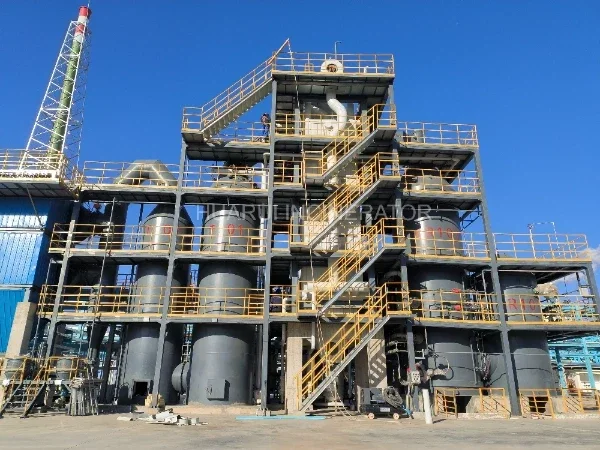
Clear records
history record
News
The Importance of Hospital Waste Incinerators: Protecting Public Health and the Environment
Introduction to Hospital Waste Incinerators
Welcome to our blog post on the importance of hospital waste incinerators! While it may not be the most glamorous topic, proper waste management is crucial for protecting public health and the environment. In healthcare facilities, such as hospitals, medical waste can pose serious risks if not disposed of correctly. That's where hospital waste incinerators come into play. These powerful machines play a vital role in safely and efficiently disposing of hazardous materials while minimizing their impact on our surroundings. So let's dive in and explore why hospital waste incinerators are so essential in safeguarding both our well-being and the planet we call home. Let's get started!
The Dangers of Improperly Disposing Hospital Waste
Improperly disposing of hospital waste can have serious consequences for public health and the environment. When medical waste is not handled correctly, it can lead to the spread of infectious diseases and pose a threat to both healthcare workers and the general population.
One of the main dangers of improper disposal is the potential for contamination. Medical waste often contains hazardous materials such as blood, bodily fluids, needles, and pharmaceuticals. If these items are not disposed of properly, they can end up in landfills or water sources, where they can contaminate soil and water supplies.
Another risk associated with improper disposal is the transmission of infectious diseases. Pathogens present in medical waste include bacteria, viruses, and other microorganisms that can cause illnesses such as hepatitis B and C, HIV/AIDS, and tuberculosis. If these pathogens come into contact with people through direct or indirect means (such as contaminated surfaces), there is a high likelihood of disease transmission.
Furthermore, improperly disposed hospital waste also poses risks to wildlife ecosystems. Animals may come into contact with discarded materials while scavenging for food or nesting materials. This exposure puts them at risk for injury or illness due to sharp objects like needles or from ingesting toxic substances.
The environmental impact cannot be ignored either. Incinerating medical waste in specialized facilities ensures complete destruction of harmful pathogens without releasing toxins into the atmosphere compared to other methods such as landfilling which presents significant risks including chemical leakage over time.
In order to mitigate these dangers associated with improper disposal practices hospitals must follow strict guidelines set by regulatory bodies regarding segregation at source; proper labeling; usage containers compliant with safety standards; safe transportation process etc.
How Incineration Works
Hospital waste incinerators play a vital role in ensuring the safe and proper disposal of medical waste. But have you ever wondered how these incinerators actually work? Let's take a closer look!
Hospital waste is carefully segregated into different categories such as infectious waste, sharps, laboratory waste, and pharmaceuticals. This segregation process ensures that each type of waste can be effectively treated during the incineration process.
Once the wastes are properly sorted, they are fed into the incinerator chamber where they undergo intense heat treatment. The temperature inside an incinerator can reach up to 1,000 degrees Celsius! At this high temperature, most organic materials are completely destroyed through combustion.
During the burning process, harmful gases and pathogens present in the medical waste are also neutralized or eliminated. Advanced filtration systems are used to trap any remaining pollutants before releasing clean air back into the environment.
The residue left behind after incineration is called ash. This ash goes through further treatment to ensure it is non-toxic and can be safely disposed of in designated landfills.
Incineration technology has come a long way over the years with continuous improvements being made to make it more efficient and environmentally friendly. Modern hospital waste incinerators now incorporate advanced monitoring systems that regulate air emissions and maintain optimal operating conditions.
Benefits of Using Hospital Waste Incinerators
Hospital waste incinerators play a crucial role in protecting public health and the environment. While some may argue that alternatives exist, there are several key benefits to using hospital waste incinerators.
Incineration is an effective method for destroying infectious waste. With the ability to reach high temperatures, it ensures complete destruction of pathogens, reducing the risk of spreading diseases. This is especially important in healthcare facilities where contaminated materials can pose significant threats if not properly disposed of.
Hospital waste incinerators contribute to air pollution control. Advanced technologies have been developed to minimize emissions and ensure compliance with strict regulations. Incineration effectively captures and neutralizes harmful substances, preventing them from being released into the atmosphere.
Additionally, by utilizing hospital waste incinerators, healthcare facilities can reduce their carbon footprint. Incineration allows for energy recovery through heat generation which can be used for various purposes such as heating or electricity production. This reduces reliance on fossil fuels and promotes sustainability within the healthcare sector.
Furthermore, hospital waste incinerators offer convenience and efficiency in waste management processes. They provide a centralized system where all types of hazardous medical wastes can be safely disposed of without compromising public safety or environmental integrity.
Regulations and Guidelines for Operating Incinerators
Regulations and guidelines play a crucial role in ensuring the safe and responsible operation of hospital waste incinerators. These regulations are put in place to protect public health and the environment from any potential harm that may arise from improper disposal practices.
One important aspect of operating an incinerator is obtaining the necessary permits and licenses. Health regulatory agencies require hospitals to adhere to specific protocols for waste management, including using approved incineration technologies and meeting emission standards.
Furthermore, regular monitoring and reporting are essential in maintaining compliance with these regulations. Incinerator operators must conduct routine inspections, keep records of waste quantities burned, monitor emissions, and report any incidents or deviations from established procedures.
Proper training is also vital for individuals involved in operating an incinerator. Employees should receive comprehensive education on safety protocols, handling hazardous materials, fire prevention measures, as well as emergency response procedures.
Additionally, there are guidelines regarding the types of waste that can be safely disposed of through incineration. Hazardous materials such as pharmaceuticals or certain chemicals may require separate treatment methods due to their potential impact on air quality or soil contamination.
Compliance with these regulations not only ensures the protection of public health but also helps prevent environmental pollution. Hospital administrators must prioritize following all applicable guidelines rigorously to maintain a safe healthcare facility while minimizing its ecological footprint.
Common Misconceptions about Incineration
There are several common misconceptions surrounding the use of hospital waste incinerators. Let's address some of these misconceptions and shed light on the truth behind them.
One major misconception is that incineration releases harmful pollutants into the environment. While it is true that incineration produces emissions, modern hospital waste incinerators are equipped with advanced technologies to minimize these emissions. These technologies include scrubbers and filters that capture and remove harmful substances before they are released into the atmosphere.
Another misconception is that incinerators contribute to global warming. While it is true that burning waste emits carbon dioxide, proper operation and maintenance of incinerators can significantly reduce greenhouse gas emissions. In fact, studies have shown that well-managed medical waste incineration has a lower carbon footprint compared to other methods like landfilling or autoclaving.
Some people also believe that using an alternative method like landfilling or autoclaving is more cost-effective than using an incinerator. However, when considering the long-term costs associated with managing hazardous medical waste, such as potential contamination of groundwater or soil, incineration proves to be a safer and more environmentally friendly option.
It's important to note that not all hospitals have access to reliable alternative methods for disposing of their medical waste. In many developing countries or remote areas, where infrastructure may be lacking, hospital waste incinerators provide a crucial solution for safe disposal.
While there may be concerns and misconceptions surrounding hospital waste incinerators, it's essential to understand the advancements in technology and regulations implemented in recent years. With proper operation and maintenance practices in place, hospital waste incinerators play a vital role in protecting public health and minimizing environmental impact.
Alternative Methods for Hospital Waste Disposal
In addition to hospital waste incinerators, there are alternative methods available for the disposal of healthcare waste. These methods aim to minimize environmental impact and protect public health while still ensuring proper waste management.
One such method is autoclaving, which involves using high-pressure steam to sterilize and disinfect medical waste. This process effectively eliminates harmful pathogens and reduces the volume of solid waste by up to 20%. The sterilized waste can then be safely disposed of in landfills or used as a fuel source in certain industries.
Another option is chemical treatment, where specific chemicals are applied to the waste to neutralize any hazardous substances. This method typically involves shredding or grinding the waste before treating it with chemicals that break down organic matter and kill bacteria.
Some hospitals also utilize microwave technology for treating their medical waste. Microwaves heat up the waste quickly, killing bacteria and rendering it safe for disposal. This method has been found effective in reducing both infectious microorganisms and overall volume of biomedical wastes.
Furthermore, some facilities opt for plasma gasification or pyrolysis processes. These advanced technologies use extreme heat to convert medical wastes into non-hazardous materials like ash, gas, or oil through controlled combustion without producing harmful emissions.
While these alternative methods offer viable solutions for hospital waste disposal, it's important to note that they may not be suitable for all types of healthcare facilities due to factors such as cost, infrastructure requirements, regulatory compliance considerations etc. Therefore each hospital should carefully evaluate its unique circumstances when choosing an appropriate method.
By exploring alternative options alongside traditional incineration techniques, hospitals can find sustainable approaches that meet their specific needs while preserving public health and protecting our environment from hazardous medical wastes.
Conclusion: The Crucial Role of Proper Waste Management in Healthcare Facilities
Proper waste management is an essential aspect of running a healthcare facility, and hospital waste incinerators play a crucial role in protecting public health and the environment. These specialized incinerators are designed to safely dispose of the hazardous materials generated by medical facilities, ensuring that they do not pose a risk to patients, staff, or communities.
By using hospital waste incinerators, healthcare facilities can effectively eliminate the dangers associated with improperly disposing of medical waste. This includes preventing the spread of infectious diseases, reducing the risk of contamination from sharp objects like needles and scalpels, and avoiding potential harm from toxic substances. Incineration provides a reliable method for destroying these hazardous materials completely.
The process of hospital waste incineration involves subjecting medical waste to high temperatures within specially designed chambers. This intense heat breaks down organic matter while neutralizing pathogens and toxins present in the waste. The resulting ash is then carefully disposed of according to strict regulations and guidelines.
There are several benefits to utilizing hospital waste incinerators. First and foremost is their ability to minimize health risks by ensuring proper disposal methods for all types of medical wastes. Additionally, incineration helps reduce pollution as it eliminates harmful emissions that would otherwise be released into the atmosphere during other disposal methods such as landfilling or open burning.
To maintain safety standards when operating hospital waste incinerators, regulatory bodies have established specific regulations and guidelines that must be followed by healthcare facilities. These rules aim to ensure proper installation, operation, monitoring systems, emission limits compliance, training programs for operators as well as regular inspections.
Despite misconceptions surrounding its environmental impact or emissions produced during combustion processes used in older technologies – modern-day hospital waste incinerators adhere strictly with stringent regulations addressing air quality control measures making them environmentally friendly solutions for managing this type of hazardous material effectively.
Eliminating Medical Waste: The Revolutionary Hospital Incinerator Solution
Related news







